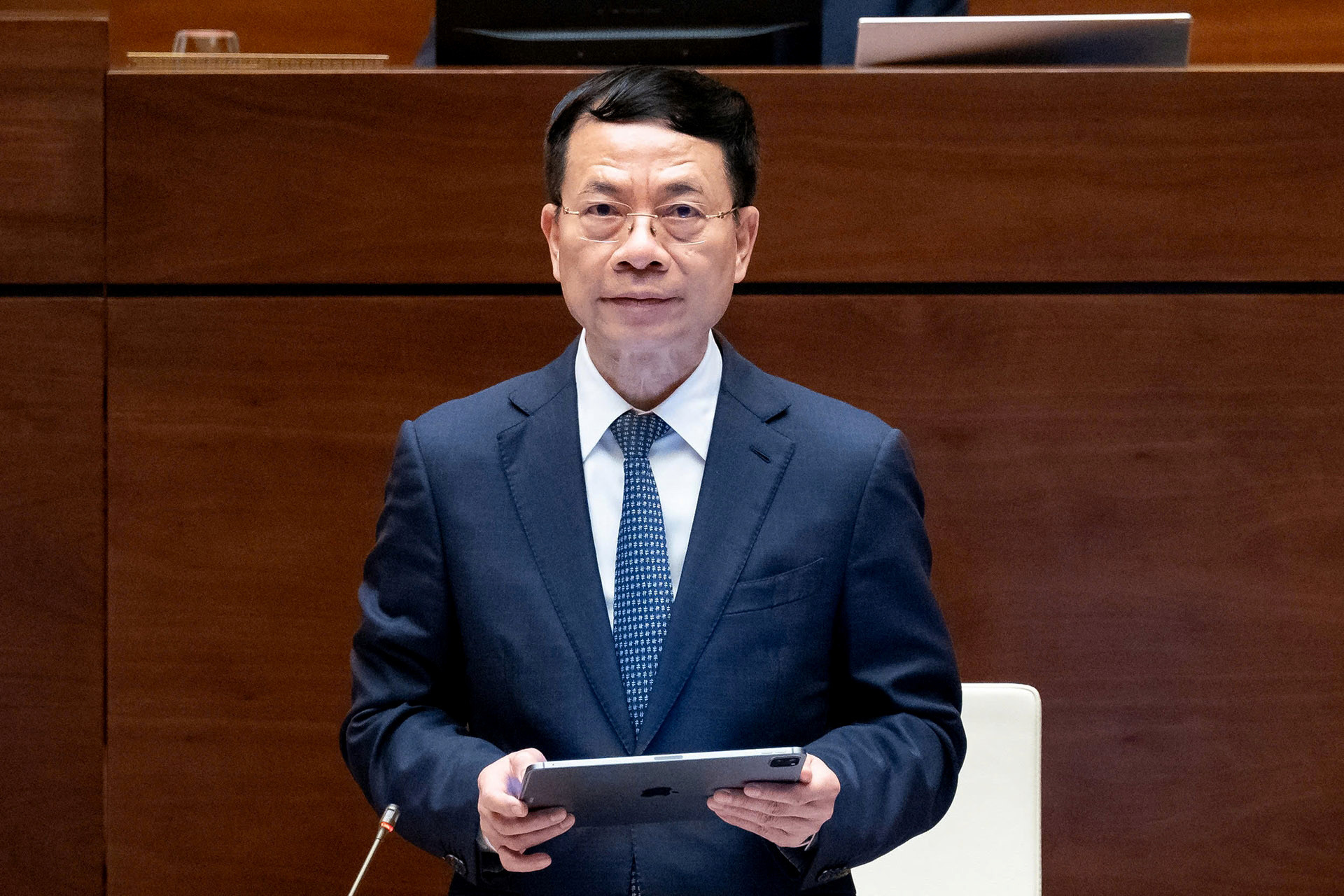On the morning of February 17, Minister of Information and Communications Nguyen Manh Hung provided clarifications on key concerns raised by National Assembly delegates regarding the draft resolution.
Minister Nguyen Manh Hung stated that all discussions and feedback were aimed at ensuring the resolution is practical, revolutionary, and effective in addressing urgent issues.
The goal is to create breakthroughs in science, technology, and digital transformation, aligning with the Politburo’s Resolution 57.

Minister of Information and Communications Nguyen Manh Hung. Photo: NA
Addressing concerns about the resolution’s title, the drafting committee proposed renaming it: “Resolution on Piloting Special Policies and Mechanisms for Breakthroughs in Science, Technology, Innovation, and Digital Transformation.”
Minister Hung emphasized that the resolution does not seek to resolve all existing challenges, particularly given its short preparation time. Instead, it focuses on a few key policies under the National Assembly’s authority that can be immediately implemented to address long-standing bottlenecks and create momentum for rapid development.
By May, the National Assembly is expected to pass the Law on Science, Technology, and Innovation, along with the Law on Digital Technology Industry, followed by other related laws. These will provide a more comprehensive legal framework to address systemic issues. Many of the concerns raised by delegates will be incorporated into these upcoming laws.
The drafting committee will also consider removing policies that require further research and evaluation, such as the self-governance mechanism for scientific and technological institutions.
Financial management reforms and risk acceptance in research
Regarding financial management in research, the resolution proposes granting greater autonomy in the use of research funds and accepting risks associated with research projects.
Minister Hung noted that research inherently carries high risks, yet the current system seeks to minimize risk by imposing complex procedures and excessive accountability measures on research institutions. This has deterred them from undertaking ambitious, high-risk projects, particularly in fundamental research.
To address this, the resolution proposes a lump-sum funding mechanism for most research projects, without requiring predetermined final outcomes. Instead, funding will be managed based on periodic evaluations to determine whether projects should receive continued financial support.
The resolution also stipulates that researchers will not be held liable or required to return funds if a project does not achieve its expected results.
“With these new policies, along with distinct management approaches for fundamental and applied research, we hope to increase the national research and development budget from the current 1% of GDP to at least 2%, as stipulated by the Law on Science and Technology,” Minister Hung said.
Strong policies for research commercialization
Commercializing research results remains a major challenge. Minister Hung emphasized that research must be translated into marketable products to contribute to economic and social development.
The draft resolution proposes allowing research institutions to own and independently decide on the commercialization of research outcomes and assets generated from research projects. This will enable them to commercialize results immediately after a project concludes.
Researchers will receive at least 30% of commercialization proceeds and will be permitted to establish and manage businesses to bring their innovations to market.
“These are bold policies aimed at unlocking the potential of past and present research, benefiting both the country and individuals,” Minister Hung stated. “When research is commercialized, the government benefits through tax revenue, job creation, and technological advancement - an indirect way for the state to recover its investment in scientific research.”
Infrastructure and digital transformation priorities
On telecommunications infrastructure, Minister Hung emphasized the urgency of accelerating investment. Resolution 57 already mandates state participation in digital infrastructure investment. To speed up investment in undersea fiber-optic cables, the resolution allows direct contract awards to Vietnamese companies developing alternative routes beyond the South China Sea.
For low-Earth orbit satellite communications, an emerging technology providing broadband coverage in remote areas, the resolution proposes allowing 100% foreign ownership of satellite telecom companies. However, these companies must meet national security and sovereignty requirements.
Fast-tracking national digital transformation
Minister Hung underscored the need for rapid progress in national digital transformation, particularly in 2025-2026, to establish foundational platforms for long-term development.
To accelerate this process, the resolution proposes a direct contract award mechanism for certain digital transformation projects. In response to concerns from National Assembly members, the drafting committee will refine the conditions under which direct contracting is allowed, ensuring transparency through auditing and post-implementation reviews.
Semiconductor industry development
Semiconductors are a strategic industry, and Vietnam aims to develop capabilities across the entire value chain. The most challenging aspect is establishing fabrication plants, particularly the first one, which is crucial for chip design, prototyping, defense, and security applications, as well as workforce training.
A small-scale semiconductor fabrication facility, costing under $1 billion, is more like an advanced laboratory than a full-scale factory. Minister Hung suggested that the government should fully fund the project but also proposed incentives to attract private sector participation.
The draft resolution proposes government support covering 30% of total investment costs for semiconductor facilities. Some lawmakers have suggested increasing this support to 50% if implementation is accelerated.
Additionally, the resolution allows companies to use science and technology funds for semiconductor investments, recognizing that these projects are more about research and development than commercial production. It also proposes allowing companies to allocate more than 10% of their science and technology funds toward semiconductor investments over several years./.
